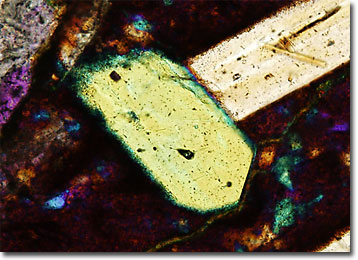Polarized Light Microscopy Digital Image Gallery
Volcanic Sandstone
Sandstones are sedimentary rocks characteristically comprised of sand-sized grains of material cemented together, although sometimes in newer sandstones the interstitial space between grains is empty. The most common cementing materials found in the rocks are silica, calcium carbonate, and iron oxides.

Abundant around the world, shale is the only sedimentary rock more common on Earth than sandstone. This fact, along with the diverse textures and mineral compositions the rock may exhibit, makes sandstone a valuable tool for geologists trying to achieve a better understanding of the erosional or depositional actions that have taken place in specific locales. Sandstones are perhaps more broadly utilized, however, for construction purposes. When simply quarried and cut, they make excellent building stones, and when crushed, sandstone may be used in a manner similar to common sand.
When volcanoes erupt, they may emit a variety of materials, such as lava, gases, and pyroclastic rocks, which may vary greatly in size from sand-like particles to sizable boulders. If accumulations of the sand-sized grains become lithified over time, the material that results is often referred to as volcanic sandstone. Because of its relation to eruptions, this type of sandstone is most prevalent in areas that have historically been associated with heavy volcanic activity, such as Naples, which stands in the shadow of Mt. Vesuvius. Due to the unique qualities of volcanic sandstone, one of the most complex and expansive underground systems in the world can be found beneath this Italian city. Though the carving of this amazing underworld was begun thousands of years ago, large numbers of Naples inhabitants have utilized the system of chambers and aqueducts as recently as the 1940s, when they served as emergency air raid shelters during World War II.
